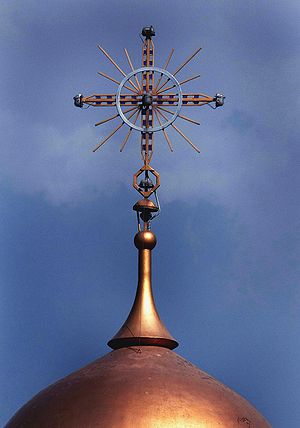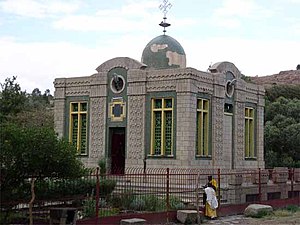
- Image via Wikipedia
The Name of the Church
The Ethiopian Orthodox Church is also known as the Ethiopian Orthodox Tewahedo Church. The word Tewahedo, which means, “made one,” was chosen to profess the one nature of our Lord Jesus Christ.
Historical Origins
The Ethiopian Orthodox Church, indigenous to Africa, is both one of the oldest churches in the world and a founding member of the World Council of Churches. The church was the creator of Ethiopia’s arts, crafts and literature, as well as the secular and theological educational institutions. Until the time of Emperor Menelik II, the church was responsible for educating the nation. Even the Fetha Nagast (“The Law of the Kings”), which comprises both canon and civil law, is the creation of the church.
Ethiopia was the first African nation to worship the one true God of the Old Testament. This was officially established by the Queen of Sheba on return from her historic visit to King Solomon in Jerusalem. Their union produced King Menelik I. The ancient Kebra Nagast (“The Glory of the Kings”) states that when Menelik grew up, he visited his father Solomon in Jerusalem and returned home accompanied by Azarias, the son of Zadok the High Priest, and many other Israelites. They carried with them the Ark of the Covenant, and placed it in St. Mary of Zion Church in Axum, the birthplace of Ethiopian civilization.
Ethiopia embraced Christianity and has maintained its doctrines from the era of the apostles to the present day. Acts 8:26-39 recounts the story of the Ethiopian eunuch who was baptized by St. Philip. This eunuch was a minister of Candace, Queen of Ethiopia. This story is the beginning of Ethiopian Church history. Eusebius speaks of this eunuch as the first fruits of the faith in the whole world. Irenaeus writes that he preached the Gospel to the Ethiopians. Tradition further records that the apostle Matthew preached the gospel to the Ethiopians and won a few converts to the new doctrine before leaving the country.
The book of St. Tekle Haimanot recounts that in the beginning of the fourth century, Meropius, a pilgrim from Tyre, came to Ethiopia accompanied by two young men, Frumentius and Aedesius, both Christians. They were received graciously by Anbaram the High Priest. Meropius fell ill and died, but the two young men remained in Ethiopia. Later, Frumentius was chosen to go to Alexandria, where Patriarch Athanasius consecrated him bishop and sent him back to Axum. He was known there as Abba Selama, “Father of Peace.”
According to some historians, the introduction of Christianity to Ethiopia was during the reign of King Ezana (320-356), the first African king to become a Christian and make Christianity the official religion of his empire.
Nine Syrian saints who came to Ethiopia in the fifth century also made a large contribution to the growth of the church by translating books from Greek, Hebrew, Syriac, and other tongues into the classical Ethiopian language of Geez and by propagating the Gospel, as well as founding monasteries and schools. During the same period, Yared, the famous church musician and man of literature, composed his major works, which still characterize the Ethiopian Orthodox Church today.

- Image via Wikipedia
Major Turning Points in History
For centuries, the Christian Ethiopians fought for the maintenance of the Christian faith against internal and external foes.
In 968, a Jewish persecution of Christians occurred under Yodit (Judith).
Later, there was constant hostility from the Moslems of the Red Sea coast. In 1528, Ahmed Gran, a Moslem, attacked the country with the aid of Turkish troops. For over a decade innumerable monasteries and churches were sacked and burned, and ancient manuscripts and other works of art were stolen.
The third and greatest problem was the attempt of the Roman Catholic Church from 1520 to 1631 to bring the Ethiopian Christians under the jurisdiction of Rome. Several missionaries were sent to proselytize as a result of contacts with King Manuel and King Joam of Portugal, initiated by Empress Eleni and her son Lebna Dengel of Ethiopia. They desired to fortify their country against the Turkish menace by making an alliance with a Christain power, and to protect the Holy Land. Among the notable missionaries was Pedro Pais, who reached Ethiopia in 1603 and converted Emperor Susneyos of Ethiopia to the Catholic faith.
Pedro Pais ordered the people to kneel to him as representative of the pope. Priests of the Ethiopian Church had to be reordained by him, and the whole population of the country was regarded as heathen if not rebaptized in the Catholic faith. Churches had to be reconstructed and altars rebuilt in the Portuguese style. Meanwhile, Susneyos decreed the death penalty for those who refused to accept the Chalcedonian formula of 451, which the Ethiopians had rejected. The people revolted, civil war broke out, and thousands were killed. After Susneyos died in 1631, his son Fasilades expelled the Jesuit missionaries from the country.
After the mission of the Portuguese Jesuits ended, several Christological formulas emerged, two of which were Qebat (Anointing) and Tsegga (Son of Grace). Qebat states that Jesus became perfect man and perfect God by anointing of the Holy Spirit in the Jordan River, and not at the Incarnation. Tsegga professes three births: the Son’s eternal birth from the Father, the Son’s generic birth from the Virgin Mary, and His birth from the Holy Spirit during baptism. These teachings caused controversy and division in the church, especially during the reign of Emperor Tewodros II (1855-1868). Such doctrinal formulas were stamped out by decree of Emperor Tewodros and by Yohannes IV, who succeeded him.
Another attempt at proselytism was made during the Italian occupation under Mussolini (1935-1941).
From the beginning, the Ethiopian Orthodox Church was affiliated with the See of St. Mark of Alexandria. After the death of Frumentius, the first bishop of Ethiopia, Egyptian Coptic bishops were appointed to head the Ethiopian Church. This continued until early in the twentieth century. However, numerous problems such as language and distance from Alexandria made it imperative to have native bishops, and after a long period of struggle beginning in 1926, agreement was finally reached with the Copic Patriarchate in 1950. Abuna Basilios, an Ethiopian, was consecrated metropolitan.
In 1959, the Church of Ethiopia was granted autocephaly (full independence), while remaining in canonical union with the Coptic Church. This granting of autocephaly was crowned on April 6, 1971. On that day, the See of Addis Ababa was elevated to patriarchal rank, and Abuna Theophilus was elected Patriarch.


